The Ultimate Queso Recipe: Flavorful and Easy

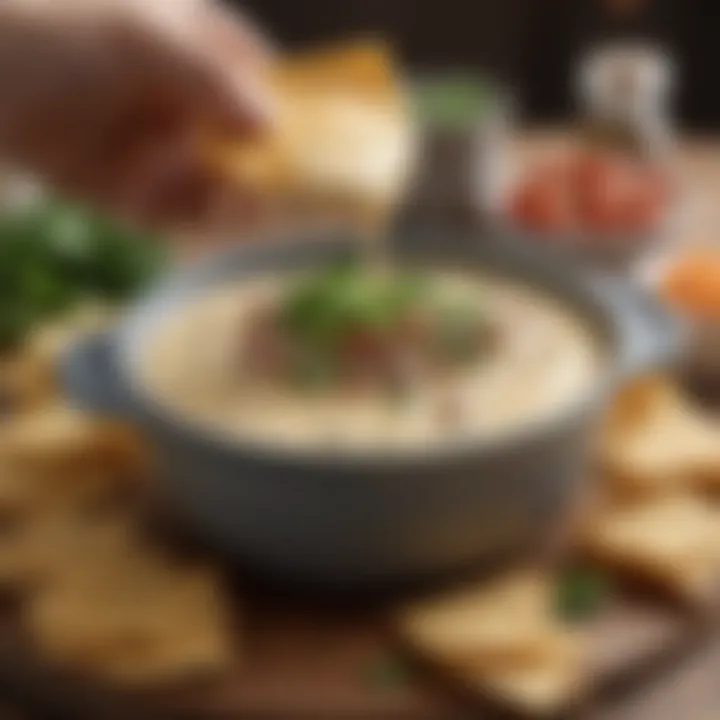
Intro
Queso, a beloved staple in Tex-Mex cuisine, has become a universal favorite for its creamy texture and rich flavor. In this comprehensive guide, we delve into how to create an exceptional queso dish that delights both casual diners and culinary aficionados alike. Queso, which translates to "cheese" in Spanish, often incorporates multiple ingredients, resulting in diverse variations that cater to individual preferences.
This guide not only walks through the cooking process but also examines the history of queso, its cultural significance, and the art behind selecting ingredients. Whether you're hosting a gathering or indulging in a cozy night at home, mastering a queso recipe can elevate your culinary skills.
The aim here is to empower cooks of all levels with the knowledge and confidence to whip up a cheese dip that not only satisfies cravings but also impresses loved ones.
Let’s embark on this savory journey into the world of queso.
Recipe Highlight
Introducing Creamy Cheddar Queso, a delightful blend of velvety cheese and zesty ingredients.
Essential Ingredients
- Cheddar cheese
- Cream cheese
- Diced tomatoes with green chilies
- Garlic
- Onions
- Jalapeños
- Cumin
- Salt
- Pepper
Preparation Time
- Prep Time: Approximately 10 minutes
- Cook Time: Roughly 15 minutes
- Total Time: 25 minutes
Servings
This recipe yields about 4-6 servings, depending on appetite.
Step-by-Step Instructions
- Prepare Your Ingredients: Start by chopping onions, jalapeños, and mincing garlic. Set them aside to streamline your cooking process.
- Sauté Vegetables: In a medium saucepan over medium heat, add a little oil and sauté the onions and jalapeños until soft. This typically takes about 3-5 minutes.
- Add Garlic: Stir in the minced garlic and cook for another minute until fragrant. Be careful not to burn it.
- Melt the Cheeses: Reduce the heat to low and add the cream cheese, stirring until it’s smooth. Gradually add the shredded cheddar cheese, mixing well until completely melted.
- Incorporate Tomatoes: Add the diced tomatoes and green chilies to the cheese mixture. This adds both flavor and texture.
- Season: Sprinkle in cumin, salt, and pepper to taste. Mix well and allow the queso to simmer for a few minutes to meld all flavors together.
- Serve: Transfer to a serving bowl and enjoy with tortilla chips or your choice of sides.
Cooking Techniques
Using low heat when melting cheese helps to avoid clumping. Stirring constantly ensures even melting.
Insider advice: Avoid rushing the melting process. Patience is key for a smooth queso.
Common Mistakes to Avoid
- Not chopping vegetables small enough can lead to uneven cooking.
- Adding cheese too quickly can cause clumping. Always allow each addition to melt fully.
Variations and Substitutions
- For those avoiding dairy, consider using vegan cheese alternatives like cashew cheese.
- Add ground beef or chorizo for a meatier twist.
- Experiment with spices like smoked paprika for added depth of flavor.
Enjoy your queso with unique sides: grilled vegetables, black bean salsa, or fresh guacamole can enhance your dining experience.
Time-Saving Cooking Tips
- Prep Ahead: Chop vegetables the night before and store them in airtight containers to reduce prep time.
- Gadgets: Using a slow cooker can make the preparation more manageable. Simply set it on low and stir occasionally.
- Batch Cooking: Make a larger batch of queso and freeze portions for quick snacks.
Nutritional Information
- Calorie Count: Approximately 250 calories per serving.
- Key Nutrients: Rich in protein from cheese and contains vitamins from vegetables.
- Diet Compatibility: Adjust based on dietary needs. This recipe can be adapted for gluten-free diets by using gluten-free ingredients and can be made vegan as well.
Prolusion to Queso
Queso, often referred to as cheese dip, holds a significant place in culinary traditions, particularly within Tex-Mex cuisine. Its rich, creamy texture and melted cheese make it a favorite for many. Understanding queso is essential, as it serves not only as a delicious accompaniment to various dishes but also as a standalone star at gatherings.
The importance of queso lies in its versatility. It can adapt to numerous flavors and ingredients, allowing cooks to create unique variations that cater to different palates. Queso is not just a dish; it cultivates social moments, as it frequently appears at parties, gatherings, and family dinners.
Moreover, learning how to make queso from scratch imparts valuable cooking skills. It encourages cooks to interact with ingredients meaningfully, understanding how they interact under heat. Knowing how to balance spices and achieve the ideal cheese melt is a valuable lesson for both novice and experienced chefs.
In this section, we will explore the delightful world of queso. From its widespread appeal to the simple joy it brings, queso invites both culinary exploration and enjoyment. As we discuss various aspects of queso, we will uncover how this humble dish embodies culture and creativity in cooking.
"Queso combines simplicity with satisfaction, bridging the gap between formal dining and casual comfort food."
Understanding queso can enhance not just one’s cooking repertoire but also appreciation for its cultural significance and manifold charms.
The Historical Context of Queso
The historical context of queso is essential. Understanding where it comes from provides insights into its significance and how it has shaped culinary practices. Queso is more than a dish; it represents cultural traditions and the evolution of cuisine over centuries. Its roots intertwine with the histories of various civilizations, making it a fascinating topic for anyone interested in food.
Originating Cultures
Queso, or cheese, has a deep history that can be traced back to various cultures, particularly those in Mesoamerica. The indigenous peoples of this region had early interactions with dairy products, although the cheese we know today developed later due to European influences. The Spanish colonization introduced new ingredients and cooking techniques, influencing local cuisines and leading to the creation of what we now identify as queso.
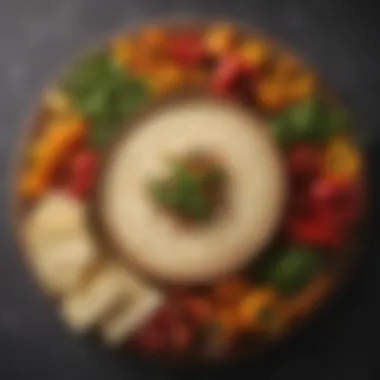
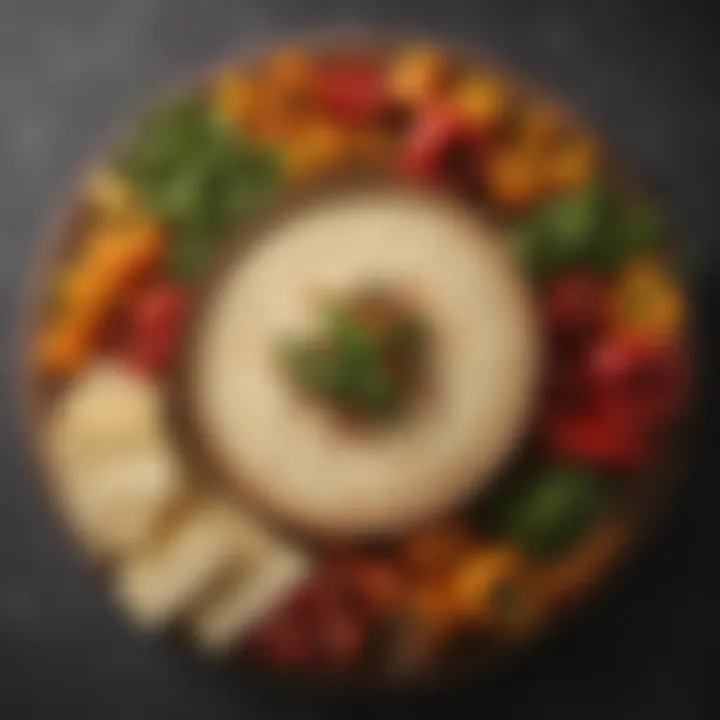
The richness of these interactions is noteworthy. For instance, the blend of Spanish cheeses with native ingredients led to unique regional variations. Each community adapted the cheese-making process, resulting in distinct flavors and textures that reflect local tastes and resources.
Evolution of Queso Recipes
The evolution of queso recipes showcases culinary innovation and cultural exchanges. Initially, cheese was prepared simply by using available tools and techniques. Over time, with the introduction of spices and other ingredients, the complexity of queso recipes increased.
In the 19th century, with the rise of Mexican-American cuisine, queso underwent significant transformation. Variations like queso dip became popular in the United States, especially within Tex-Mex cuisine. Ingredients such as tomatoes, jalapeños, and cilantro began to appear in recipes.
Today, queso continues to evolve. Chefs are experimenting with different types of cheese, dairy alternatives, and unique flavor combinations. This ongoing transformation keeps queso relevant in modern culinary discussions. Each iteration respects its origins while also adapting to contemporary tastes and dietary needs.
"The historical significance of queso lies in its ability to connect cultures through shared culinary practices, illustrating how food can bridge gaps between traditions."
In summary, grasping the historical context of queso allows for a deeper appreciation of the dish itself. Knowing where it started and how it has evolved enriches the experience for both cooks and those who enjoy this beloved cheese dish.
Essential Ingredients for Queso
The quality and combination of ingredients are what differentiate a remarkable queso from an average one. Knowing which ingredients to select is the foundation of crafting a delicious queso. This section dives into the essential components that make up queso, focusing on cheese, spices, and additional ingredients. Each one plays a critical role in the flavor and texture of the dish, ensuring that the final product is both savory and satisfying.
Cheese Selection
Choosing the right cheese is paramount. The type of cheese you use will set the tone for the entire queso. Soft, creamy cheeses melt beautifully and create a great texture. Some popular choices for queso include Velveeta, which has a smooth melting quality, and Mexican cheeses like Oaxaca or Chihuahua. These cheeses offer characteristic flavors that blend well with other elements in the dish.
"Cheese selection is an art form; the wrong choice can ruin the entire experience."
When selecting cheese, consider the following:
- Melting properties: Look for cheeses that melt smoothly.
- Flavor profile: Decide if you prefer mild or sharp flavors.
- Freshness: Fresh cheese yields better taste and texture.
Incorporating a blend of cheeses can also provide depth and complexity. Mixing sharper cheeses with creamier ones gets an enriched taste that enhances the experience.
Spices and Seasonings
Spices and seasonings elevate the flavor profile of your queso. Each contributes to the overall experience of the dish. Common spices include cumin, paprika, and chili powder. These not only add warmth but also dimension to the flavor.
Some suggested spices are:
- Cumin: Provides an earthy flavor.
- Smoked paprika: Adds a hint of smokiness.
- Chili powder: Brings heat and depth.
- Garlic powder and onion powder: Enhance the savory notes.
Always start with small amounts. Gradually increase according to your taste preference. It is crucial to balance the spices without overpowering the natural cheese flavor.
Additional Ingredients
Additional ingredients can personalize your queso, making it unique. Common additives include tomatoes, jalapeños, or green onions. Tomatoes add acidity and freshness, while jalapeños can provide heat, making them popular choices.
Consider these additions when crafting your queso:
- Tomatoes: Diced or pureed can add moisture.
- Chilies: Fresh, canned, or roasted for varied heat levels.
- Onions: Sautéed onions can introduce sweetness.
Adding proteins like ground beef or chorizo can make queso a hearty dish.
Preparation Techniques
Understanding preparation techniques is essential when it comes to creating the best queso. These methods not only affect the flavor but also the texture of the final product. Properly preparing your ingredients and employing the right cooking techniques can mean the difference between a mediocre queso and an outstanding one.
Employing traditional methods allows for an authenticity that connects to the roots of this beloved dish. Conversely, modern techniques provide efficiency and precision, allowing for a tailored approach. Utilizing a blend of both can enhance the culinary experience for cooks at any level.
Traditional Methods
Traditional methods of preparing queso often involve using cast iron skillets or stovetop pots. This approach promotes even heating, which is crucial for melting cheese without burning it. Many recipes passed down through generations emphasize slow cooking. This gradual heating helps meld flavors beautifully, allowing the spices and cheese to infuse together harmoniously.
Commonly, cooking this way requires more attention and time but can reward the cook with a richer and more complex flavor profile. Using methods like double boiling or preparing an open flame can also be traditional. Each method evokes a piece of history, connecting the cook to ancestral practices.
Modern Techniques
In contrast, modern techniques prioritize efficiency and convenience. Using appliances such as slow cookers or sous vide can simplify the preparation process considerably. A slow cooker allows for a hands-off approach, letting ingredients meld together without constant monitoring.
Moreover, using an immersion blender at the end of cooking can create a smoother texture in the queso, appealing to contemporary tastes. Cooking in a microwave also offers a quick alternative for those short on time. While modern techniques often sacrifice some traditional nuances, they can still yield a delicious queso with proper attention to timing and ingredient quality.
Adapting techniques to suit individual preferences allows home cooks to explore their own styles while mastering this cherished dish.
A Step-by-Step Guide to Making Queso
Creating the perfect queso requires attention to each phase of the cooking process. A systematic approach streamlines this task, ensuring that every flavor is developed and the texture remains creamy and smooth. This guide provides valuable insights into ingredient preparation, cooking methods, and finishing touches to help achieve a stellar queso dish.
Preparation of Ingredients

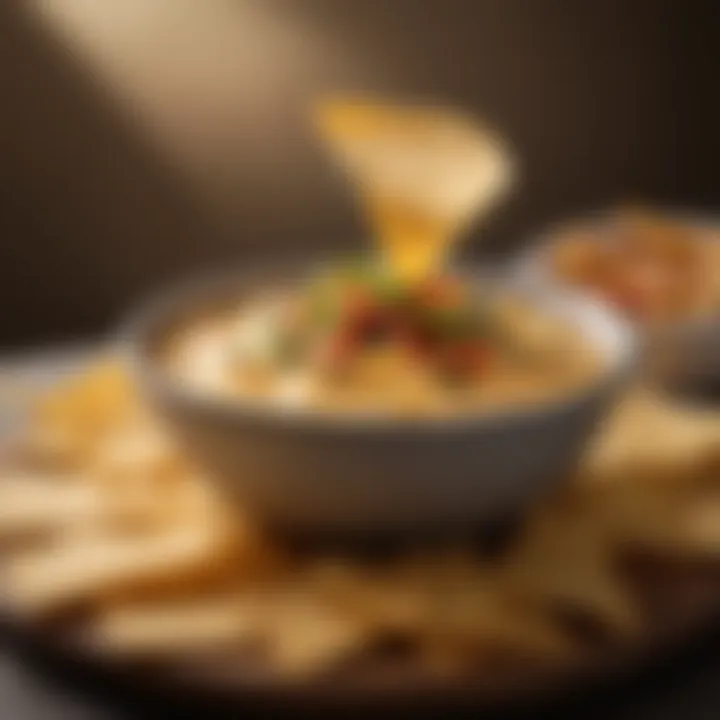
Before you embark on the cooking journey, gathering and preparing your ingredients is crucial. This initial stage influences the overall outcome of the dish. To start, choose high-quality cheeses like cheddar or Monterey Jack, and consider blending them for depth of flavor.
- Cheese: Grate the cheese just before cooking. This promotes even melting and prevents clumping.
- Vegetables: Dice onions, tomatoes, and peppers ahead of time. This allows their flavors to absorb into the dish throughout the cooking.
- Spices: Measure out chili powder, cumin, and salt beforehand for an efficient cooking process. Maintaining balance in the spice mix avoids overpowering the dish.
A well-organized workspace can save time and reduce stress during the cooking process.
Cooking Process
Now it’s time to bring the queso to life. Start slowly to build layers of flavor.
- Sauté Aromatics: Begin by heating a pan over medium heat. Add a small amount of oil, then toss in your diced onions and peppers. Cook until softened, typically around 5-7 minutes. This stage caramelizes the vegetables, heightening the overall flavor.
- Add Cheese: Gradually introduce the cheese to the pan. Lower the heat to prevent scorching. Stir continuously to ensure it melts evenly. This gentle process maintains a creamy consistency, avoiding rubbery textures.
- Incorporate Liquids: For added creaminess, mix in milk or heavy cream. The desired thickness can be adjusted by controlling the liquid amount. Ensure to keep stirring as it combines with the melted cheese, forming a cohesive blend.
- Season to Taste: At this point, add in your pre-measured spices. A taste test allows for adjustments. If you find the flavors lack depth, consider adding more of the spices or a splash of hot sauce for extra heat.
The objective here is to foster a balance where the cheese shines without being overshadowed by spices or other ingredients.
Final Touches
Once the cooking phase is complete, the finishing touches can elevate your queso from good to exceptional.
- Garnish: Chopped cilantro or green onions can add freshness and a pop of color. Place them on top just before serving.
- Texture Adjustment: If the queso appears too thick, a small splash of milk can be mixed in. Conversely, if it is too thin, simmer it a bit longer while stirring frequently.
- Serving Temperature: Ensure the queso remains warm when serving. Once exposed to air, it can cool quickly, so keep it over low heat or in a warming dish.
The secret to the best queso lies in its texture and flavor harmony, achieved by careful attention to each step in the process.
This step-by-step guide provides a detailed framework for creating a delicious queso dish. By preparing ingredients mindfully, cooking with patience, and finishing with precision, you set yourself up for success in the kitchen.
Common Mistakes in Queso Preparation
Understanding the common mistakes in queso preparation is crucial for achieving that perfect creamy texture and rich flavor. Queso is not just a dip; it holds a significant place in culinary traditions, and the quality of the final product relies heavily on the methods and ingredients used. By highlighting these pitfalls, this section aims to guide both novice and experienced cooks towards a successful queso experience.
Overheating Cheese
Overheating cheese is a frequent error that many make when crafting queso. Cheese, if subjected to excessive heat, can become oily and grainy, which is undesirable in a smooth dip. The ideal approach is to melt cheese slowly over low to medium heat. Using a double boiler can help maintain an even temperature and prevent direct contact with a hot surface, which is key to preserving the cheese's integrity.
Keep in mind the type of cheese you choose also influences melting. Varieties like Velveeta or Cheddar can handle heat differently. When your cheese starts to melt, stir gently but consistently. This ensures even melting and helps incorporate other ingredients seamlessly.
Important Tip: Always keep an eye on the temperature. Using a food thermometer can help maintain it below 185°F to avoid those unwanted textural changes.
Incorrect Ratios of Ingredients
Getting the ratios of queso ingredients wrong can lead to an unbalanced flavor profile or texture. Too much cheese can result in a dip that is too thick, while too many liquids can make the queso runny and less appealing. Therefore, measuring ingredients accurately is essential.
A typical recipe might call for a specific ratio of cheese to milk and spices. Adjusting these amounts based on preferences or specific brands can create an unnecessary challenge. Consider starting with a standard recipe, then gradually modify ratios while taking note of the results. This method helps in fine-tuning the flavors and judiciously adapting the recipe to suit personal tastes.
In summary, recognizing these common mistakes—overheating cheese and incorrect ratios of ingredients—can significantly elevate the quality of your queso preparation, allowing you to craft a dish that is both visually appealing and delicious.
Enhancements and Variations of Queso
Queso, a beloved cheese dip, is often seen as a universal comfort food. However, its potential for variation is vast. By exploring different enhancements and variations, this section delves into the creative possibilities that can elevate your queso experience. These variations cater to diverse flavor preferences and dietary needs, ensuring that every cook can find a version that suits them. Whether aiming for a spicy twist or seeking vegetarian-friendly options, understanding these elements not only enriches the dish but also allows for personalized expression in the kitchen.
Spicy Queso Variations
For those who enjoy heat, spicy queso is a delightful enhancement. Adding ingredients like jalapeños, serrano peppers, or even ghost peppers can significantly elevate the heat of your queso. This not only enhances the flavor profile but also adds an exciting kick to the dip.
- Jalapeños: Fresh or pickled jalapeños can give a mild to moderate spice level.
- Chipotle Peppers: These provide a smoky flavor along with heat. They can be added in adobo sauce or diced into the dip.
- Habanero: For the adventurous, include finely chopped habaneros for a fiery queso.
Combining these peppers with the right cheeses, such as sharp cheddar or pepper jack, creates a balance between creaminess and spiciness. Additionally, consider garnishing with fresh cilantro or green onions to complement the heat.
Vegetarian Options
Creating a vegetarian queso does not mean compromising on flavor. In fact, this option can be just as rich and satisfying as its meatier counterparts. Focus on using quality cheeses along with vegetables to create depth.
- Roasted Vegetables: Incorporating roasted bell peppers or mushrooms can add a hearty texture.
- Beans: Black beans or pinto beans provide protein, making the dip more substantial.
- Nutritional Yeast: This ingredient can impart a cheesy flavor, ideal for vegan versions.
A well-crafted vegetarian queso can be served just like traditional queso, with tortilla chips, fresh veggies, or even as a topping for nachos. Ensuring one uses spices like cumin or smoked paprika can enhance the overall flavor without meat.
Ultimately, whether opting for spicy variations or embracing vegetarian options, the world of queso offers a myriad of opportunities to personalize and adapt this classic dish.
Serving Suggestions
Serving suggestions are a crucial aspect of creating the full queso experience. While the recipe itself focuses on the ingredients and preparation, how one serves the dish can elevate the entire meal. Queso is not just a dip; it can be paired with various items that enhance its flavor and presentation. The goal here is to provide ideas that complement the richness of queso while considering different occasions and preferences of guests. This thoughtful approach can lead to a more satisfied palate.
Complementary Dishes
In planning for queso, it is wise to consider what other dishes can be served along with it. The right complementary items can create a harmonious balance of tastes and textures.
- Tortilla Chips: This is a classic pairing. Their crunchiness provides a delightful contrast to the smoothness of queso. Choose thick tortilla chips to scoop generously without breaking.
- Vegetable Platter: Fresh vegetables such as bell peppers, carrots, and celery add a crisp, refreshing element to the meal. This not only offers a healthier alternative but also provides vibrant colors that improve presentation.
- Tacos: Mini tacos filled with various proteins like chicken, beef, or beans can be served alongside. Guests can dip them in queso, creating a richer flavor profile.
- Nachos: Layering cheese, jalapeños, and other toppings on tortilla chips creates a more substantial dish. Queso can be drizzled over for extra cheesy goodness.
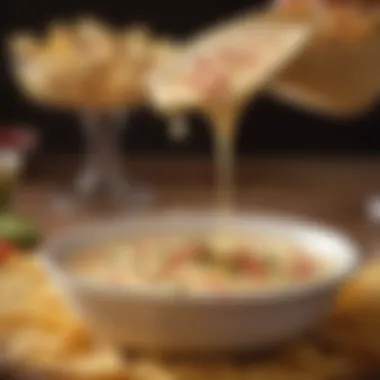
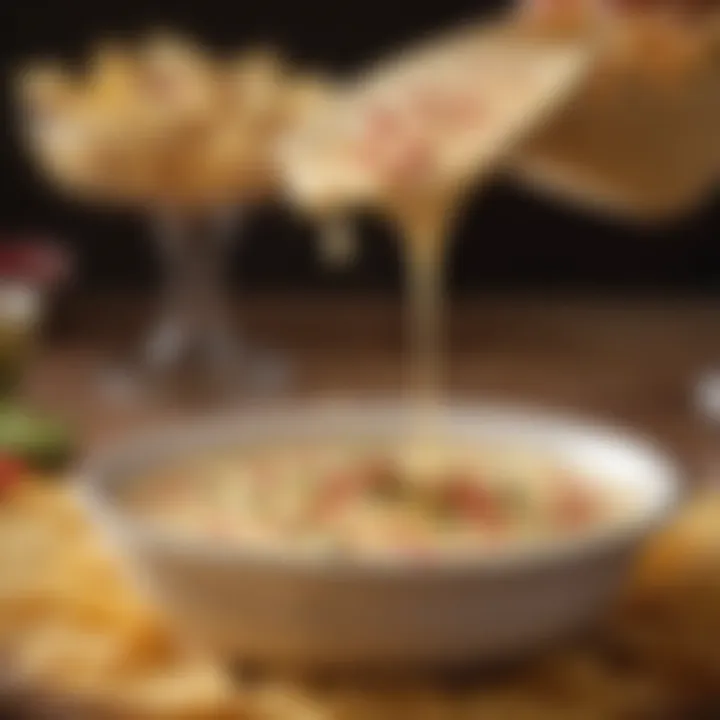
Pairing Beverages
Choosing the right beverages to pair with queso is as significant as selecting the right accompaniments. A well-matched drink can enhance the overall experience and balance the flavors of the dish.
- Craft Beer: A crisp lager or a hoppy IPA often complements the buttery and spicy notes of queso. The carbonation helps cleanse the palate between bites, enhancing the enjoyment of the dish.
- Margaritas: These refreshing cocktails, particularly lime-based ones, can cut through the richness of queso. The tartness provides a nice balance and can elevate the overall experience.
- Soda: For non-alcoholic options, a citrus-flavored soda can provide a fun and vibrant lift to the meal. The sweetness and citrus notes pair surprisingly well with cheese.
- Water: It is always a good idea to have water available, especially when dealing with spicy variations of queso. Staying hydrated enhances the experience and encourages guests to enjoy more of the meal.
"The right pairing can transform a good meal into a memorable one, making choices about serving suggestions just as important as the recipe itself."
These serving suggestions provide various options that can cater to different tastes and occasions, ensuring that your queso is more than just a stand-alone dish.
Storage and Reheating Tips
Proper storage and reheating techniques are crucial for maintaining the quality of queso. Queso, made from cheese and various ingredients, can spoil or lose flavor if not stored correctly. By understanding how to store and reheat queso, you can ensure its taste and texture remain appealing. Additionally, this knowledge allows you to minimize waste and enjoy your dishes over multiple meals.
Proper Storage Techniques
When it comes to storing queso, the method you choose can significantly affect the end result when you’re ready to eat it again. Here are some essential storage tips:
- Cooling Down: Allow your queso to cool to room temperature before storing. Placing hot queso directly in the fridge can raise the temperature inside, which is not good for any other food there.
- Airtight Containers: Use airtight containers to keep moisture out. This prevents the cheese from drying out or developing an off flavor. Glass or plastic containers with tight seals work best.
- Refrigeration: Store queso in the refrigerator if you plan to eat it within a few days. Most homemade queso can stay fresh for about three to five days.
- Freezing: If you want to keep queso for an extended period, consider freezing it. However, be aware that the texture may change after thawing. In this case, it may be beneficial to reheat with a little cream or milk to restore creaminess.
Following these techniques can significantly impact how your queso holds up over time.
Reheating Methods
Reheating queso requires care to avoid making it grainy or overly thickened. Here are some effective reheating methods:
- Stovetop: Place your leftover queso in a saucepan over low heat. Stir frequently to prevent sticking or burning. If the consistency seems thick, add a splash of milk or cream to help restore its creamy texture.
- Microwave: For convenience, you can use the microwave. Transfer the queso to a microwave-safe bowl and cover it. Heat in short intervals (15-30 seconds), stirring in between to promote even heating and avoid hot spots.
- Double Boiler: A double boiler can be helpful if you want the gentlest heating method. It reduces the risk of overheating, which is crucial for cheesy sauces. This method may take longer but helps in maintaining that desired silky smooth texture.
Proper storage and reheating are key to enjoying queso over multiple meals without losing its original flavor and consistency.
By implementing these storage and reheating tips for queso, home chefs can maintain quality and flavor, ensuring this crowd-pleasing dish remains delightful, meal after meal.
Nutritional Information
Understanding the nutritional information of queso is vital for making informed dietary choices. This includes recognizing not just the caloric content but also the health implications of the ingredients used. As queso is often enjoyed as a party dip or a side, it may carry with it certain flavor and nutritional profiles that can influence meal planning. Moreover, this knowledge helps to strike a balance between indulgence and health, allowing culinary enthusiasts to enjoy their creations without the guilt associated with high-caloric foods.
Caloric Content
In queso, caloric content primarily comes from cheese, milk, and added ingredients. On average, a one-cup serving of queso can hold anywhere from 300 to 500 calories. The type and quantity of cheese chosen can significantly impact this total. For instance, Velveeta cheese tends to yield a higher caloric density compared to lower-fat options like feta or reduced-fat cheddar.
- Cheese: The core component, providing not just calories but essential nutrients like calcium.
- Cream and Milk: Common accents that can elevate smoothness but also boost calorie count.
- Add-ins: Ingredients such as ground beef or beans can contribute additional calories.
It is important for consumers to recognize the balance between calories and nutritional value. A higher fat content may mean more calories, but also contributes to flavor and satiety, which can enhance the overall dining experience while emphasizing the pleasure of good food.
Health Considerations
When enjoying queso, it is essential to think about health implications. While queso can be rich in calcium and proteins, it is also often high in saturated fats and sodium. Here are some points to consider:
- Saturated Fats: High levels can impact heart health. Opting for lower-fat cheeses can mitigate this risk.
- Sodium: Cheese and added spices can lead to elevated sodium levels which may not be suitable for people monitoring their salt intake.
- Portion Control: Being aware of serving sizes helps in managing caloric intake while still enjoying queso. Small servings can allow for taste without excess.
Culinary Significance of Queso
Queso holds a prominent place in culinary traditions, especially in Latin American and Tex-Mex cuisines. Its significance stems from its versatility and adaptability, qualities that have allowed it to evolve across regions and cultures. Not merely a dip or a topping, queso encapsulates flavor, texture, and community, often being the centerpiece of gatherings and celebrations.
Cultural Impact
The cultural relevance of queso cannot be overstated. It is frequently associated with social interactions, bringing people together for communal meals. Many families have their own variations passed down through generations. These recipes often highlight regional flavors and ingredients, making each version unique to its area. The popularity of queso in popular culture further enhances its status. Food festivals and culinary competitions regularly feature queso, showcasing its ability to unite diverse ingredients into a singular dish that celebrates both tradition and innovation.
Popularity in Modern Cuisine
In recent years, queso has found a solid foothold in modern cuisine. Restaurant menus across the globe often include different interpretations of this dish. Many chefs experiment with novel ingredients, infusing traditional queso with gourmet elements like truffle oil or artisan cheeses. This adaptability has helped queso remain relevant in an increasingly health-conscious culinary landscape. Many recipes now emphasize fresh produce and lighter versions, catering to those seeking indulgence without sacrificing quality.
Moreover, the rise of social media has paved the way for queso to become a trending food item. Visual platforms showcase bold, appetizing images that spark interest and inspire home cooks to experiment. The hashtag #queso has gained traction, making it easier for enthusiasts to share their creations and inspire others.
The evolution of queso reflects broader gastronomical trends, signifying not just a dish, but a cultural phenomenon that connects history with modern culinary practices.
In summary, the culinary significance of queso is multifaceted, spanning cultural heritage and contemporary culinary trends. This dish continues to thrive as a beloved staple, inviting innovation while paying homage to its roots.
End
The conclusion of this article serves as a crucial focal point, synthesizing the various aspects of making the perfect queso. In discussing the recipe, we have unpacked its historical context, the essential ingredients required, various preparation techniques, and the ways to enhance and serve the dish. Emphasizing these elements not only highlights the intricacies of queso but also reinforces its relevance in modern culinary practices.
One significant aspect of this article is the encouragement it provides to home cooks. Understanding the simplicity and depth behind creating queso allows anyone—be it an experienced chef or a beginner—to take pride in their cooking endeavors. The recipe integrates a blend of textures and tastes, showcasing how a seemingly straightforward dish can elevate gatherings and enhance everyday meals.
"A well-prepared queso is not just food; it represents a sense of community and shared experience."
Additionally, the discussion on storage and reheating tips serves a practical purpose. Many may believe that queso loses its appeal over time. However, proper techniques can keep the dish delicious long after its initial preparation. By valuing the attention to detail and understanding the science behind ingredient interactions, readers can avoid common pitfalls that might otherwise detract from their culinary efforts.
Moreover, discussing the nutritional aspects of queso provides a balanced view. While it is often considered an indulgent dish, understanding its caloric content allows for mindful consumption without feeling deprived of flavor. The various dietary options highlighted emphasize inclusivity, ensuring everyone can enjoy a flavorful experience.
In summary, the conclusion reiterates the importance of queso not merely as a recipe but as a culinary tradition that unites people. This comprehensive guide empowers individuals to explore, create, and enjoy their own variants, ensuring that queso remains a versatile and beloved element in kitchens.
By integrating history, techniques, and modern adaptations, we highlight the enduring appeal of queso, encouraging food lovers to keep this delightful dish alive in their cooking repertoire.







